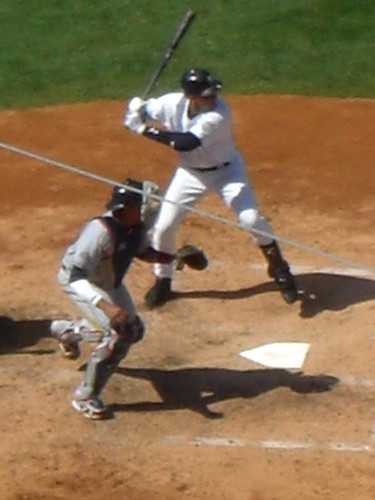Pitchout tips for Catchers
January 30, 2011 by Coach McCreary
Filed under Catching, Coaching
Yesterday’s post described why a pitchout, even if the runner does not steal on the pitch, can be valuable and what pitchers can do to make their pitchouts more effective. Today I offer four tips for catchers on pitchouts.
 |
| Make sure this guy is not looking in to steal your signs. (Photo by Computeress) |
Peek at the runner. Many base stealers at the upper level can decide to steal on their own. They are given the “green light” which means they are allowed to steal when they want to. In an attempt to pick a good pitch to steal on (anything slower or downward breaking), many of these runners will take their lead at first base and peek in at the catcher’s signs as he gives them to the pitcher. If the runner sees the pitchout sign, usually the fist or thumb, he won’t go. Catchers need to be aware of this and take a look at the runner before the sign to see if he is peeking in. If he thinks the runner is, the catcher should try to hide the signs more or change them up.
Set up outside. As mentioned in yesterday’s post, some pitchers have trouble throwing a pitchout to the proper spot. One way to help them is to give the sign and set up on the outside corner. The catcher’s body is closer to the opposite batter’s box which makes it more likely the pitchout will be thrown there instead of down the middle. Be careful though because a very smart runner may notice that a catcher does this and not steal.
 |
| This catcher correctly angles out and forward to receive the pitchout. (Photo by 2Eklectik) |
Angle out to catch. If you watch a MLB catcher carefully on a pitchout you’ll notice he does not simply stand up and move straight to the side to catch the ball in the opposite batter’s box. He angles forward as he moves to the side so that he catches the ball a foot or two quicker than if he just shifted straight to the side and waited for a full length throw. This also starts to build some momentum forward before catching the ball.
Timing. The timing of when to get up and angle out into the opposite batter’s box is important as well. Too early may tip it off and too late defeats the purpose of a pitchout. It might vary based on each pitcher’s delivery but the best time to start moving is when the pitcher’s throwing hand starts to come forward in his delivery. That usually gets the ball and the catcher to arrive at the proper pitchout spot at the right time.





Leave a Reply